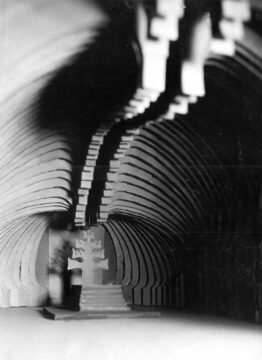„A Farkasréti ravatalozó meglévő épületét a harmincas évek elején építették. A jobboldali szárnyat, a templomot a II. világháborúban bombázták le. A megmaradt falakból kolumbárium épült. A középső öt helyiségből álló épületrészt alakítottuk át tágasabbra. Az elülső folyosót a szertartástermekhez csatoltuk. Az épület külsején nem változott semmi. Az 1991-es teljes felújításkor a négy oldalsó teremből az eredeti berendezés részbeni megtartásával két ravatalozót alakítottunk ki.”
„A ravatalozó belsejét az ember mellkasának belsejéhez hasonlóvá akartam alakítani. A „bordák” keményfából készültek. A halott a szív helyén fekszik. „
A ragasztott fatartókból készített érzékeny vonalvezetésű ívek a földig futnak, a kijárat felé azonban növénykehelyként nyílnak meg. A ravatalozó bejáratára deszkaszárnyak készültek, szárnyak, amit mint motívumot Makovecz Imre itt alkalmazott épületeiben először. A ravatal fejéhez készült mozgatható jelképek, kereszt és életfa, a használat során rövid időn belül eltűntek. A terem oldalán sorakozó, a bordaközökbe épített székeket Mezei Gábor iparművész tervezte.
- október 8-án Makovecz Imrétől is itt vettek búcsút barátai, tisztelői. A ravatalozótól mintegy 250 méter sétával elérhető síremléke, mely az eredetileg Nagykapornakra, gyermekkora nyarainak színhelyére tervezett harangláb.

















